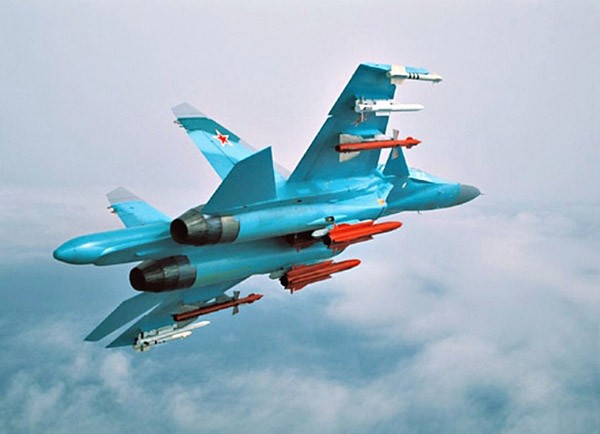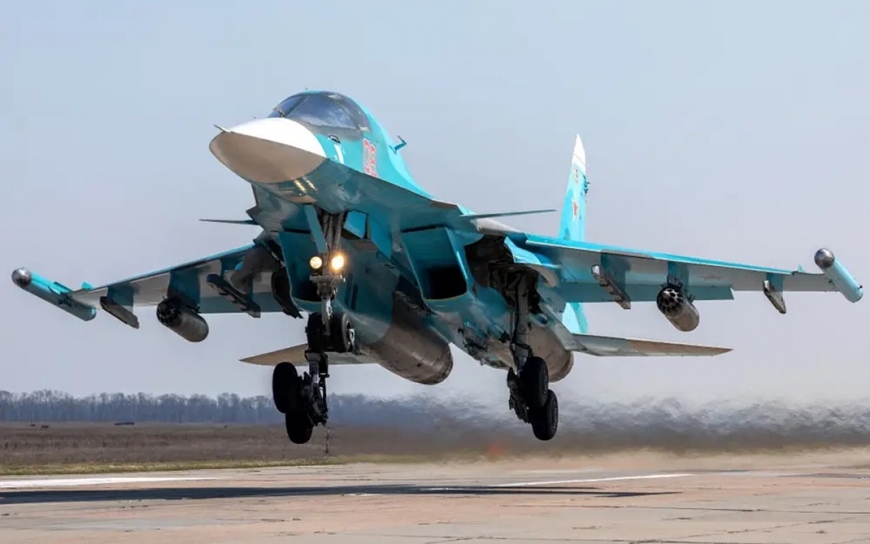The Sukhoi Su-34, a twin-engine, twin-seat strike fighter developed by the Sukhoi Design Bureau, exemplifies the blend of tactical versatility and advanced technology in modern military aviation. Known for its robust design, impressive payload capacity, and state-of-the-art avionics, the Su-34 plays a critical role in Russia’s air combat operations. This article explores the Su-34’s design, capabilities, operational history, and strategic importance.

Design and Development
The Su-34, also known by its NATO reporting name “Fullback,” is derived from the Sukhoi Su-27 family but significantly modified to fulfill its strike fighter role. The aircraft features a side-by-side seating arrangement for its two crew members, providing a more spacious and comfortable cockpit environment for long-duration missions. This configuration also enhances coordination between the pilot and the weapons systems officer.
One of the most distinctive features of the Su-34 is its “duckbill” nose design, housing a powerful radar and avionics suite. The aircraft’s fuselage is designed for reduced radar cross-section, enhancing its survivability against enemy air defenses. Its twin-engine configuration, powered by Saturn AL-31F turbofan engines, provides high thrust and excellent performance across a wide range of altitudes and speeds.

Advanced Avionics and Systems
The Su-34 is equipped with a sophisticated avionics suite that includes advanced radar systems, electronic warfare (EW) capabilities, and navigation aids. The primary radar, the Leninets V004, is capable of air-to-air and air-to-ground modes, allowing the Su-34 to detect, track, and engage multiple targets simultaneously.
The aircraft’s electronic warfare suite includes radar warning receivers (RWR), electronic countermeasures (ECM), and infrared countermeasures (IRCM). These systems provide the Su-34 with robust self-protection capabilities, enabling it to operate effectively in contested environments. Additionally, the Su-34 features a modern glass cockpit with multifunction displays (MFDs), providing pilots with critical flight and mission data.
Armament and Combat Capabilities
The Su-34’s armament is one of its most significant strengths, allowing it to perform a variety of combat roles, including ground attack, interdiction, and suppression of enemy air defenses (SEAD). The aircraft is equipped with a 30mm GSh-30-1 cannon, and it has 12 hardpoints for carrying a diverse array of weapons.
For air-to-ground missions, the Su-34 can be armed with Kh-29, Kh-31, and Kh-35 missiles, as well as various types of guided and unguided bombs. Its precision-guided munitions enable it to strike high-value targets with accuracy. In air-to-air combat, the Su-34 can carry R-77 and R-73 missiles, providing it with the capability to defend itself against enemy fighters.
The Su-34’s payload capacity exceeds 8,000 kg (17,636 lbs), making it one of the most heavily armed aircraft in its class. This capability allows it to undertake multiple mission types in a single sortie, enhancing its operational flexibility.
Operational History and Strategic Importance
The Su-34 has been actively deployed by the Russian Air Force since its introduction in the mid-2000s. It has seen combat in various theaters, including the Syrian Civil War, where it played a crucial role in conducting precision airstrikes against insurgent targets. The aircraft’s performance in Syria demonstrated its effectiveness in real-world combat scenarios, showcasing its ability to deliver sustained, accurate firepower.
The Su-34’s strategic importance lies in its versatility and capability to conduct a wide range of missions. Its advanced avionics, robust self-protection systems, and heavy payload capacity make it a valuable asset for modern air forces. The aircraft can operate in high-threat environments, providing close air support (CAS), interdiction, and deep strike capabilities.
International Interest and Exports
While the Su-34 is primarily operated by the Russian Air Force, it has also attracted interest from other countries. Potential export customers recognize the Su-34’s capabilities and its potential to enhance their own air combat operations. However, the aircraft’s advanced technology and strategic significance mean that its export is closely controlled by the Russian government.
Future Prospects
The future of the Su-34 looks promising, with continued upgrades and enhancements planned to maintain its effectiveness in modern combat. Ongoing improvements in avionics, weapons systems, and electronic warfare capabilities will ensure that the Su-34 remains a formidable strike fighter for years to come. Additionally, the development of new variants may expand its operational roles and further enhance its versatility.
Conclusion
The Sukhoi Su-34 stands as a testament to Russian ingenuity in military aviation, offering a potent combination of firepower, advanced technology, and tactical flexibility. Its ability to perform a wide range of missions, from deep strike to air interdiction, makes it a critical component of Russia’s air combat capabilities. As the Su-34 continues to evolve, it will undoubtedly remain a cornerstone of modern air warfare, showcasing the enduring legacy of the Sukhoi design bureau.





